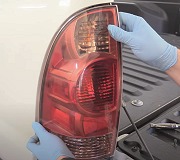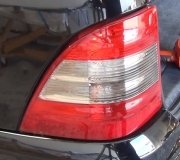The diagrams are from AllData which uses a copy from the manufacturer's paper service manual.
AMC vehicles were a combination of parts from multiple manufacturers. Automatic transmissions came from Chrysler. Generators came from GM. Starters came from Ford. I don't know the history behind their original wiring harnesses.
Just so I don't incorrectly assume something, .. :
"headlight switch, when its on, ignition off, the blinkers you can hear, but no lights on or flashing"
Does that occur all the time or do you have to activate the signal switch? What is used for the flasher? Is it the old, very reliable two-terminal thermal flasher that worked fine for decades, or is it one of the new type with lots of terminals? If it's the two-terminal type, when it is clicking but shouldn't be because the ignition switch is off, start at the flasher's terminal that has 12 volts on it. That 12 volts should not be there with the ignition switch off. Try to follow that wire back and see where it comes from.
Be aware too that those thermal flashers requited current flow through them to heat up the heating element that causes them to flash. That means if the flasher is clicking, current has to be going somewhere. Turn off your garage lights, then look closely at all the bulbs to see if they're glowing dimly. This type of flasher will flash real slowly if a bulb is burned out, or if there's excessive resistance, such as when there's a bad ground for one of the bulbs. To complicate the issue even more, they can be wired internally two different ways. In one style, the contacts are turned on when the unit is relaxed. The signal lights will be on the instant you turn the signal switch on, then the heating element will get hot and cause them to flash off. In the second style, the contacts are off when relaxed. The bulbs will be off the instant the signal switch is turned on, then current has to flow through the heating element and bulbs. That causes the contact to flip to "on". Doing so shorts out the heating element. The bulbs will be bright and the thermal contact will cool down, then the contacts turn off a fraction of a second later. With either of these, the flasher should stop clicking when some or all of the bulbs are removed from their sockets.
There was a much less-common three-terminal flasher that is becoming popular when using LED signal lights that don't draw enough current to make the thermal flashers work.
Along with the same two terminals, one for 12 volts and one going to the lights, there's a third ground terminal. This one starts out with the contacts turned on. The instant the signal switch is turned on, current flows to the bulbs and to the heating element. The heat causes the contacts to click open, (off). That turns the bulbs off along with the heating element. The contact cools and clicks back on and repeats. That type of flasher unit will click at a constant rate regardless if any bulbs are connected, or the number of bulbs. Connecting a trailer, for example, won't have any effect on the flash rate. If this is the type of flasher you have, it can indeed flash with no bulbs being connected to the circuit by the signal switch. The diagnosis would be the same. Find the terminal with constant 12 volts and follow that wire back to see where it is coming from.
For original equipment, the diagram shows the same style flasher for the signals and for the hazard flasher. They're the two-terminal type with the heating element in series with the contacts, and those contacts start out in the "on" position. If one signal bulb is removed or is burned out, current flow will be too low. The working light(s) will be on full brightness, and the flasher will click off too slowly or not at all.
Sunday, November 22nd, 2020 AT 2:59 PM











